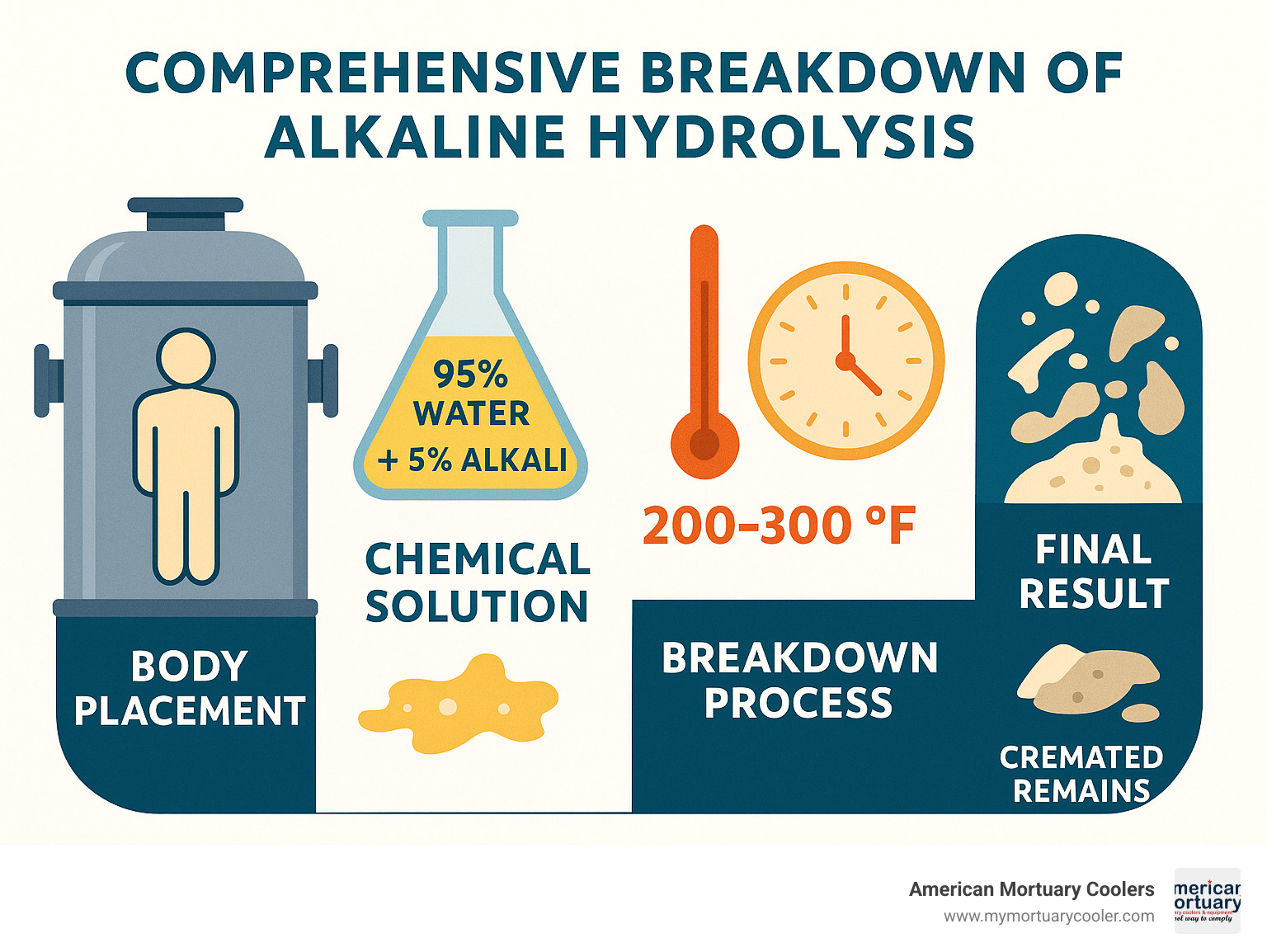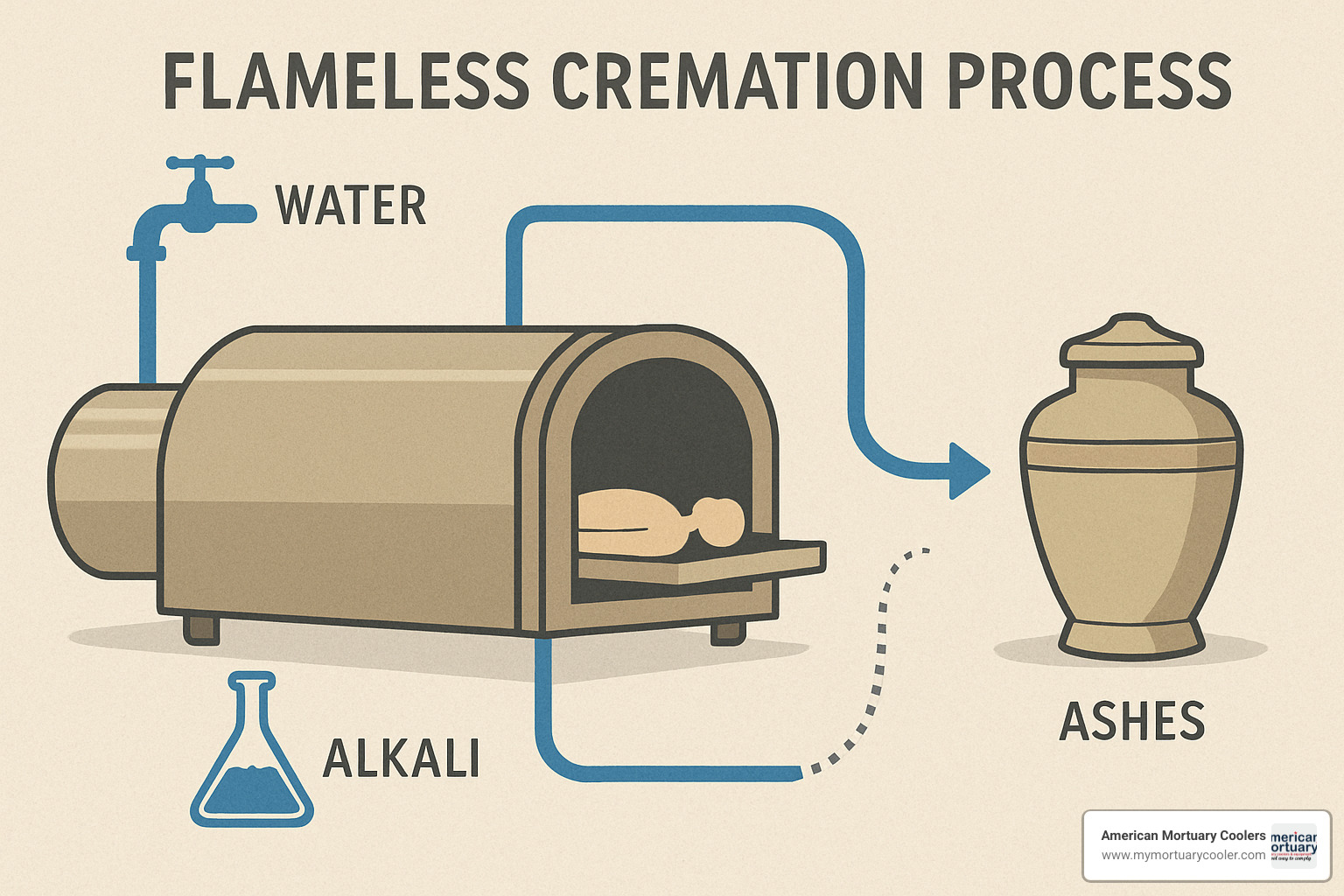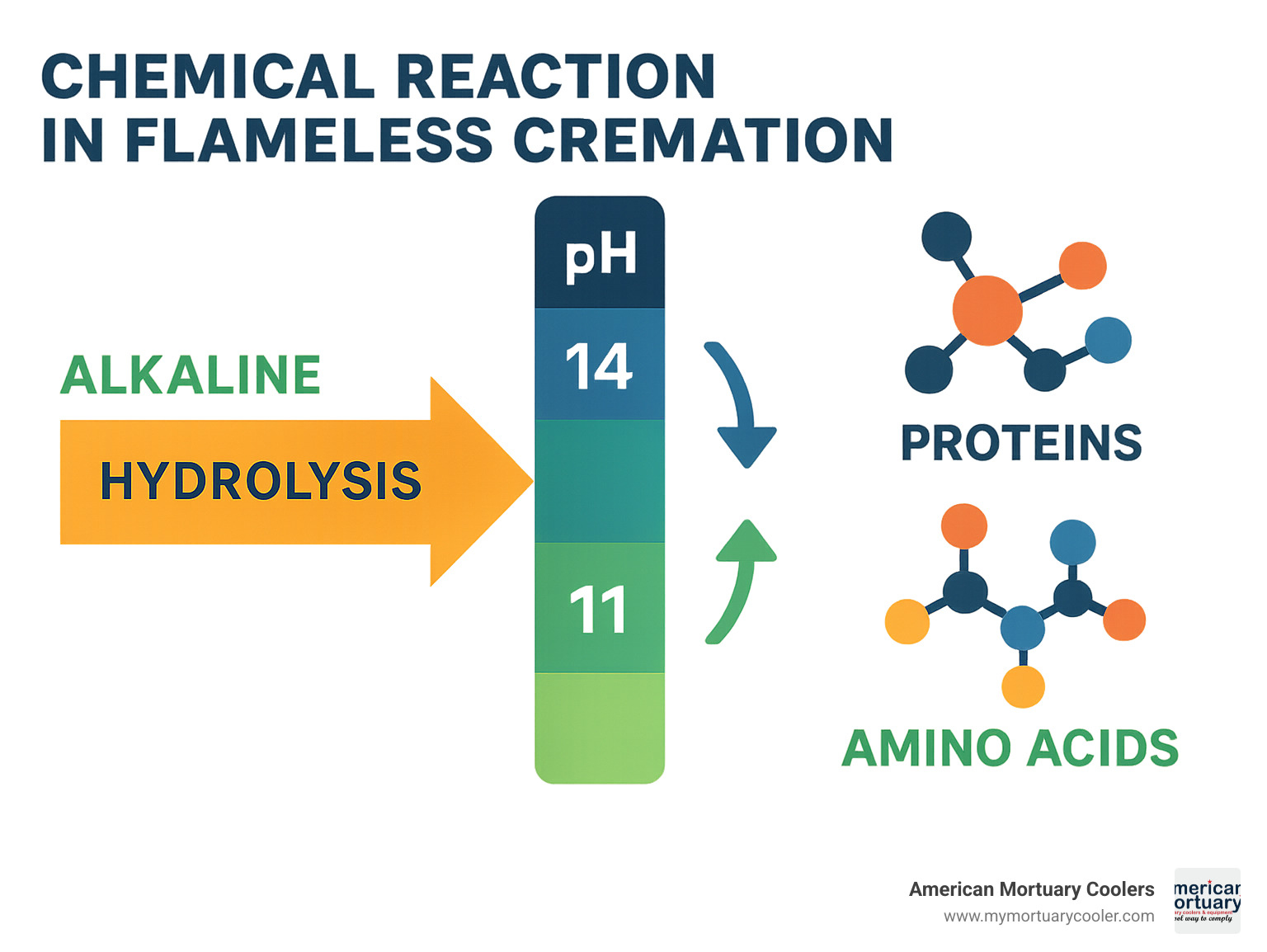Why the Flameless Cremation Process is Revolutionizing End-of-Life Care
The flameless cremation process is changing how families say goodbye to their loved ones, offering a gentle, eco-friendly alternative to traditional fire-based cremation. Also known as alkaline hydrolysis, aquamation, or water cremation, this innovative method uses heated water and alkaline chemicals to accelerate natural decomposition without flames.
Quick Overview of the Flameless Cremation Process:
- Body Placement - Deceased is placed in a stainless steel pressure vessel
- Chemical Solution - Chamber fills with 95% water and 5% alkali (potassium or sodium hydroxide)
- Heat & Pressure - Temperature reaches 200-300°F under controlled pressure
- Breakdown Process - Takes 4-16 hours to dissolve soft tissues naturally
- Final Result - Only bone fragments remain, which are dried and processed into ash
- Clean Byproduct - Sterile liquid effluent contains only salts, amino acids, and sugars
The process mimics what naturally happens during soil decomposition but accelerates it through controlled chemistry. No flames, no emissions, no mercury vapor - just a gentle return to basic elements.
Environmental benefits are significant. The flameless cremation process uses 90% less energy than traditional cremation, reduces carbon footprint by over 75%, and produces about 32% more cremated remains for families. It's currently legal in 24 U.S. states and growing rapidly as funeral homes recognize both its environmental advantages and gentler approach.

Flameless cremation process further reading:
What Is Flameless Cremation?
When most people think of cremation, they picture flames and high heat. But there's a gentler way that's been quietly revolutionizing how we care for our loved ones after death. Flameless cremation uses the power of water instead of fire, creating a peaceful alternative that many families find more comforting.
This process goes by several names - aquamation, alkaline hydrolysis, water cremation, biocremation, and resomation. They all describe the same gentle method that works with your body's natural composition rather than against it.
Our bodies are about 65% water, so using water as the primary medium for breakdown just makes sense. The flameless cremation process combines 95% water with 5% alkali - simple chemicals like potassium hydroxide or sodium hydroxide that you'd find in everyday soap and cosmetics. This alkaline solution mimics what happens naturally when we return to the earth, just much faster and in a controlled environment.
The temperature difference is remarkable. While traditional flame cremation burns at a scorching 1,600-1,800°F, flameless cremation works gently at 200-300°F. Combined with pressure and gentle agitation, this creates the perfect conditions for natural tissue breakdown without any combustion, flames, or harmful emissions.
Key Terms & History
The roots of this technology stretch back to 1888 when alkaline hydrolysis was first patented for processing animal remains. The real breakthrough came in 1993 when the first commercial system designed specifically for human remains was installed at a medical college. The Mayo Clinic became a champion of this technology, starting to use alkaline hydrolysis for their anatomy program in 2006.
Minnesota broke new ground in 2003 as the first state to legalize the process. Since then, 24 states now welcome alkaline hydrolysis as a legal disposition method, with more states considering new legislation each year.
Benefits in a Nutshell
The advantages of choosing the flameless cremation process speak to both our hearts and our planet's health.
For the environment, this gentle process uses over 90% less energy than traditional cremation while reducing your carbon footprint by over 75%. It produces zero harmful emissions, mercury vapor, or greenhouse gases. The water usage is surprisingly modest - less than what a typical household uses in a single day.
Families often appreciate the practical advantages. You'll receive approximately 32% more cremated remains compared to flame cremation, and the ashes come out whiter and cleaner-looking without carbon discoloration. Medical implants remain intact and can be recycled responsibly. Many people find comfort in choosing a method that doesn't involve fire.
The memorial options remain exactly the same as traditional cremation. You can still choose beautiful urns, scatter ashes in meaningful places, or create lasting tributes that honor your loved one's memory.
To learn more about this eco-friendly alternative, check out our detailed guide: Aqua Cremation Explained: A Water-Based Alternative.
The Step-by-Step Flameless Cremation Process

When families choose the flameless cremation process, they often wonder what actually happens during the procedure. The entire process takes place inside a specially designed stainless steel pressure vessel that looks like a large, sophisticated pressure cooker.
The process starts with gentle preparation. The deceased is carefully placed into the stainless steel chamber, then the vessel is filled with the alkaline solution - 95% water and 5% alkali. Unlike traditional flame cremation, there's no rush to remove pacemakers or most medical implants. The flameless cremation process won't damage them, and they can be easily separated and recycled afterward.
Once sealed, the chamber heats to a controlled 200-300°F and becomes pressurized to prevent the water from boiling away. Computer systems constantly monitor and adjust temperature, pressure, and pH levels throughout the entire process.
The combination of heat, pressure, alkalinity, and gentle agitation creates the perfect environment for accelerated hydrolysis - nature's own decomposition process with a helpful boost from modern technology.

Understanding the Flameless Cremation Process Chemistry
The chemistry behind the flameless cremation process is actually quite neat. The process begins with a high pH alkaline solution around pH 14 - very alkaline, similar to some industrial cleaners. This solution breaks down proteins, fats, and other organic tissues through saponification and hydrolysis.
It's the same chemical reaction that happens naturally when a body decomposes in soil, just happening much faster and in a controlled environment. As the process continues, the pH gradually drops from 14 to about 11 as the alkaline chemicals get "used up" breaking down the organic matter.
The primary reaction involves hydroxide ions attacking the bonds that hold proteins and fats together. Proteins break down into amino acids, fats convert to soap, and other organic compounds dissolve completely. The process is so thorough that no DNA remains in the final liquid.
Temperature control is crucial throughout the process. At higher temperatures around 320°F, the cycle takes 4-6 hours. At gentler temperatures of 208°F, the process extends to 14-16 hours.
Timeline of the Flameless Cremation Process
The complete flameless cremation process follows a carefully planned timeline that typically spans 10-12 hours from start to finish.
Body placement begins the process as the deceased is respectfully positioned in the stainless steel vessel. The chamber fills with the alkaline solution, and the system seals and begins its initial heat-up phase. During the first two hours, temperature gradually rises while pressure builds.
Active hydrolysis represents the heart of the flameless cremation process. This phase lasts 4 to 16 hours depending on temperature settings. During this time, the primary tissue breakdown occurs while gentle agitation helps distribute the chemicals evenly.
The rinse and cool phase begins once breakdown is complete. The system starts controlled cooling while pressure is gradually released. Multiple rinse cycles remove any residual chemicals, ensuring the bone fragments are completely clean.
Bone processing comes next. The clean bone fragments are removed and dried, then processed in a cremulator - the same machine used in traditional cremation to create uniform ash. Any metal implants are carefully separated for recycling. Finally, the cremated remains are placed in a temporary container for urn return to the family.
The sterile effluent that remains contains only salts, amino acids, sugars, and soap - completely safe byproducts that go to the municipal wastewater treatment system.
The entire process, from beginning to family return, typically takes 7-10 days total. This includes processing time, documentation, and coordination with the family's chosen funeral home.
For families curious about the technical details, our comprehensive guide Going Out With a Splash: How Water Cremation Works offers an even deeper look into the mechanics of this fascinating process.
Flameless vs. Flame Cremation: Environment, Cost & Energy
When families weigh disposition options, the numbers highlight why the flameless cremation process is considered the greener choice.
Energy use is the quickest way to compare. Flame cremation needs roughly 360 kWh to reach 1,600-1,800 °F, while alkaline hydrolysis operates at 200-300 °F and averages 90 kWh—a 90 % reduction.
Lower heat also means cleaner air. Fire cremation releases mercury from fillings and CO₂ equal to a 1,000-mile road trip. Flameless cremation vents no greenhouse gases or mercury, and the sterile liquid by-product is already safe for municipal treatment plants.
Because no bone is lost to combustion, families receive about 32 % more remains, and the ashes are naturally whiter. Intact medical implants can be recycled, recovering metals that would otherwise be land-filled.
While the hydrolysis cycle lasts 4-16 hours (vs. 2-3 hours of burning), the overall 7-10-day paperwork window is identical. Pricing also stays close; many providers report only modest differences that vary by region.
| Comparison Factor | Flameless Cremation | Traditional Cremation |
|---|---|---|
| Energy Use | 90 kWh | 360 kWh |
| Emissions | None | CO₂ + mercury |
| Carbon Footprint | −75 % | Baseline |
| Cremated Remains | 32 % more, whiter | Standard |
| Cycle Time | 4-16 h | 2-3 h |
| Medical Implants | Recyclable | Destroyed |
For a deeper cost breakdown see: Alkaline Hydrolysis vs Cremation: The Cost Winner Revealed. Environmental context: What is aquamation?.
Safety, Regulations & Religious Acceptance
When families consider the flameless cremation process, safety questions naturally arise. The good news is that alkaline hydrolysis has an exceptional safety record that actually surpasses traditional cremation in many ways.
Public Health Safety: The process creates a completely sterile environment that destroys all pathogens, viruses, and bacteria. The high pH alkaline solution combined with controlled heat eliminates even the most resistant infectious agents. What emerges is remarkably clean - sterile effluent containing no DNA, no tissue fragments, and no pathogens.
Medical implants present zero safety concerns during the flameless cremation process. Unlike flame cremation, where pacemakers must be surgically removed to prevent dangerous explosions, they can safely remain in place during alkaline hydrolysis. Hip replacements, dental work, and surgical hardware emerge completely intact and ready for recycling.
Regulatory Status: The legal landscape for flameless cremation continues expanding across America. Currently, 24 states have legalized the process, with more considering legislation each year. Minnesota pioneered the way in 2003, largely thanks to advocacy from the Mayo Clinic. Since then, states from coast to coast have recognized the benefits, including California, New York, Illinois, Washington, Oregon, and many others.
Religious Perspectives: Religious acceptance of the flameless cremation process varies significantly, often depending on how different faiths view the body and its treatment after death.
The Catholic Church has engaged in thoughtful bioethical analysis of alkaline hydrolysis. While some dioceses have accepted it as consistent with treating the body with dignity and respect, others maintain reservations. The process aligns well with Catholic environmental stewardship principles.
Protestant denominations generally show greater acceptance, particularly those already comfortable with traditional cremation. Many Protestant leaders see flameless cremation as consistent with caring for God's creation through environmental responsibility.
Eastern Orthodox Christianity, Orthodox Judaism, and Islam traditionally oppose all forms of cremation, viewing bodily preservation as important for resurrection beliefs. However, some progressive voices within these communities are beginning discussions about whether water-based disposition might be fundamentally different.
Hindu, Sikh, and Buddhist traditions, which already accept cremation as spiritually appropriate, tend to be more open to flameless alternatives. The environmental benefits often resonate with these faiths' emphasis on minimizing harm and living in harmony with nature.
Addressing Misconceptions: Unfortunately, misinformation about the flameless cremation process persists. The biggest misconception is that bodies are "dissolved in acid." This is completely false. The process uses alkaline solution - the opposite of acid - with the same basic chemicals found in soap and cosmetics.
Another myth suggests the process somehow harms the environment. In reality, the sterile effluent contains only natural decomposition byproducts that enter wastewater systems every day from normal human activities. The discharge is actually cleaner than typical household wastewater.
Some people worry this is "new, untested technology." Actually, alkaline hydrolysis has been used safely for over 30 years, with extensive adoption by medical institutions and research facilities. The Mayo Clinic has used it since 2006 with complete success.
For thorough fact-checking on common misconceptions, Reuters provides excellent analysis: Fact Check on alkaline hydrolysis.
To understand the legal landscape in your specific area, check our comprehensive state-by-state guide: Water Cremation and Aquamation Laws in Your State.
Memorialization & Why Families Choose It

The reasons families gravitate toward flameless cremation are as varied as the families themselves. Many are drawn by the environmental legacy it creates. Instead of releasing hundreds of pounds of carbon dioxide into the atmosphere, their loved one's final act actually contributes to cleaner water systems. For families who spent years choosing sustainable products, this gentle process feels like a natural extension of those values.
Others find comfort in the gentler nature of water-based cremation. The idea of flames can be deeply troubling for some people, whether due to personal trauma, cultural background, or simply an intuitive preference for something that feels more peaceful. Water is associated with cleansing, renewal, and life itself.
The quality and quantity of remains also matters to many families. The flameless cremation process produces about 32% more cremated remains than traditional fire cremation, and the ashes are notably whiter and cleaner-looking without carbon discoloration. For families wanting to divide ashes among children or create multiple memorial pieces, this extra volume makes a meaningful difference.
Some families choose water cremation for religious considerations. While traditional cremation remains forbidden in certain faiths, some religious authorities view alkaline hydrolysis differently since it doesn't involve fire. This nuanced distinction has opened doors for families who want the practical benefits of cremation while respecting spiritual concerns.
The memorialization options with flameless cremation ashes are beautifully diverse. Traditional choices like urn storage, cemetery burial, and scattering work exactly the same as with conventional cremation. But families often get creative with options that honor both their loved one and the environment.
Cremation jewelry and keepsakes allow family members to carry a small portion of ashes in pendants or rings. Living reef projects appeal to ocean lovers who want to contribute to marine ecosystems. Tree planting with biodegradable urns creates living memorials that grow stronger over time, literally putting down roots in meaningful places.
Post-Process Options
The flexibility that comes with cremated remains gives families precious time to plan meaningful celebrations without the pressure of immediate decisions. Military families can wait for burial slots in national cemeteries. Families with deployed service members can delay services until everyone can gather.
Urn choices range from simple temporary containers to elaborate custom pieces reflecting personal interests. Biodegradable options for earth or water burial appeal to environmentally conscious families. Keepsake urns allow multiple family members to have a portion of ashes.
The service timing flexibility proves invaluable during grief. Unlike traditional burial that requires quick decisions, cremated remains can be stored safely while families process their loss and plan appropriate tributes. Some hold immediate celebration-of-life services, while others wait for meaningful dates like birthdays or anniversaries.
Documentation follows the same standards as traditional cremation, with certificates and permits ensuring legal compliance for transport or scattering. Whether families choose immediate memorialization or wait months to scatter ashes in a special location, the process accommodates their needs with dignity and respect.
For families considering costs and planning ahead, our detailed breakdown covers all the financial aspects: Breaking Down the Cost of Water Cremation.
Frequently Asked Questions About the Flameless Cremation Process
Below are the questions funeral directors hear most often.
Does the alkaline solution harm the environment?
No. The solution is 95 % water and 5 % potassium or sodium hydroxide—the same alkali found in many soaps. During the cycle the chemicals are completely neutralised. The effluent that leaves the vessel is sterile, has a pH of roughly 11, and contains only salts, amino acids, sugars and soap. Every state that has legalised alkaline hydrolysis has reviewed and approved this discharge. Unlike flame cremation, it releases no CO₂ or mercury into the air.
What happens to medical implants and pacemakers?
Because temperatures never exceed 300 °F, most devices remain undamaged. Pacemakers can stay in place without risk of explosion, and metal implants such as hips or knees are easily separated afterward for recycling. That saves families a surgical removal fee and keeps valuable titanium, stainless steel, and gold out of landfills.
Will I receive “ashes” like with flame cremation?
Yes. The final remains are the same calcium-phosphate bone minerals produced by fire cremation—just 32 % more of them and naturally white because there is no carbon. After drying, the fragments are processed in a cremulator and returned in a temporary container ready for scattering, burial, jewelry, or any memorial option you would choose with traditional ashes.
Conclusion
The flameless cremation process is quietly revolutionizing how we think about end-of-life care. What started as a scientific curiosity in 1888 has become a meaningful option for families who want to honor their loved ones while protecting the planet they leave behind.
At American Mortuary Coolers, our role in supplying mortuary cooling equipment has given us a unique perspective on how funeral homes are adapting to serve families choosing eco-friendly alternatives. From our service areas spanning Johnson City TN to Los Angeles, from Atlanta GA to Chicago IL, funeral directors tell us the same thing: families appreciate having options that align with their values.
The numbers tell a compelling story. Using 90% less energy than traditional cremation while producing 32% more cremated remains isn't just good for the environment - it's better for families too. No mercury emissions, no greenhouse gases, and no carbon discoloration of the ashes. Just a clean, dignified process that mirrors what happens naturally in soil.
What strikes us most is how the flameless cremation process addresses concerns we didn't even know families had. The fear of fire that some people carry their whole lives. The desire for whiter, cleaner-looking ashes. The wish to leave a lighter footprint on the earth. These aren't small considerations when you're making decisions during grief.
The legal landscape continues expanding as more states recognize the benefits of this technology. With 24 states already on board and more considering legislation, we're watching a fundamental shift in how Americans think about disposition of remains. The Mayo Clinic's early adoption helped legitimize the process, and now funeral homes nationwide are investing in the equipment and training needed to offer this service.
For funeral professionals considering this addition to their services, the investment goes beyond equipment. It's about positioning your funeral home as forward-thinking and environmentally conscious. It's about serving families who might otherwise look elsewhere for their values-based choices.
Behind every technical process is a grieving family seeking dignity and peace during their most difficult time. Whether they choose traditional burial, flame cremation, or the flameless cremation process, our job remains the same: providing reliable equipment and support so funeral professionals can focus on what they do best - caring for families.
The future of funeral service includes more sustainable practices, and alkaline hydrolysis is leading that charge. As American Mortuary Coolers, we're committed to supporting funeral professionals with durable, reliable equipment for every modern disposition method they choose to offer.
The choice between cremation methods ultimately comes down to what feels right for each family. By understanding all available options - including this gentle, water-based alternative - families can make decisions that bring comfort and align with their values during the grieving process.
For more insights into this evolving landscape, explore our detailed analysis: Water Cremation Redefining End-of-Life Care.
















